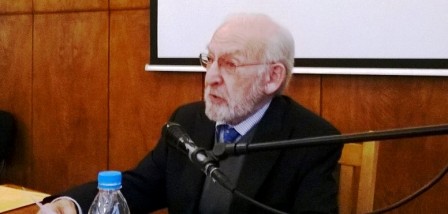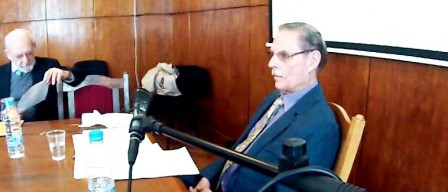INTERDISCIPLINARY SHAKESPEARE SEMINAR “WHAT IS HAMLET TO US”
“THE MYSTERIES OF HAMLET”– public lecture by Prof. JAY L. HALIO
 Jay L. Halio, Professor Emeritus of English, has been teaching for over half a century, beginning at the University of California, Davis, and then the University of Delaware. He has been a visiting professor at many universities abroad, including the University of Sofia, where he was a Fulbright lecturer in the spring of 2005. He has published widely on Shakespeare as well as on modern British and American fiction.
Jay L. Halio, Professor Emeritus of English, has been teaching for over half a century, beginning at the University of California, Davis, and then the University of Delaware. He has been a visiting professor at many universities abroad, including the University of Sofia, where he was a Fulbright lecturer in the spring of 2005. He has published widely on Shakespeare as well as on modern British and American fiction.
The lecture will discuss a number of unanswered questions, inconsistencies, and major issues in Shakespeare’s tragedy. Chief among them will be the nature of the Ghost, the reason(s) for Hamlet’s delay, and Gertrude’s culpability. Several scenes will lend themselves to very close reading and interpretations, including those not generally held by other scholars. Questions and/or demurrers will be welcomed after the talk.
https://www.youtube.com/watch?v=KzwDnmlFcAs
“WORDS, WORDS, WORDS AND THE MEETING OF MINDS IN HAMLET”– public lecture by Prof. TOM CLAYTON
 Tom Clayton is a Regents Professor of English Language and Literature at the University of Minnesota. He took his doctorate at Oxford University and taught at Yale University and the University of California, Los Angeles. He writes on Shakespeare and seventeenth-century English poetry. He has recently come upon “semetrics,” a way of scanning much pre-modern English verse on the inference that meter makes meaning.
Tom Clayton is a Regents Professor of English Language and Literature at the University of Minnesota. He took his doctorate at Oxford University and taught at Yale University and the University of California, Los Angeles. He writes on Shakespeare and seventeenth-century English poetry. He has recently come upon “semetrics,” a way of scanning much pre-modern English verse on the inference that meter makes meaning.
Hamlet has been called the only credible genius in Western literature, cause enough for differences of interpretation. “He” is a locus where minds meet, complement, and sometimes conflict. Among the manifold causes are (1) the words that express Hamlet and Hamlet; (2) the minds themselves, which are primarily ours (the reader’s), Shakespeare’s (as expressed in the play), and Hamlet’s (as enabled by “his” dialogue); and (3) the three early substantive texts, commonly referred to as Q1 (1603), Q2 (1604-05), and F (1623). The lecture shall try to identify several of Shakespeare’s possible Hamlets.
https://www.youtube.com/watch?v=wdRKDS_HuQU